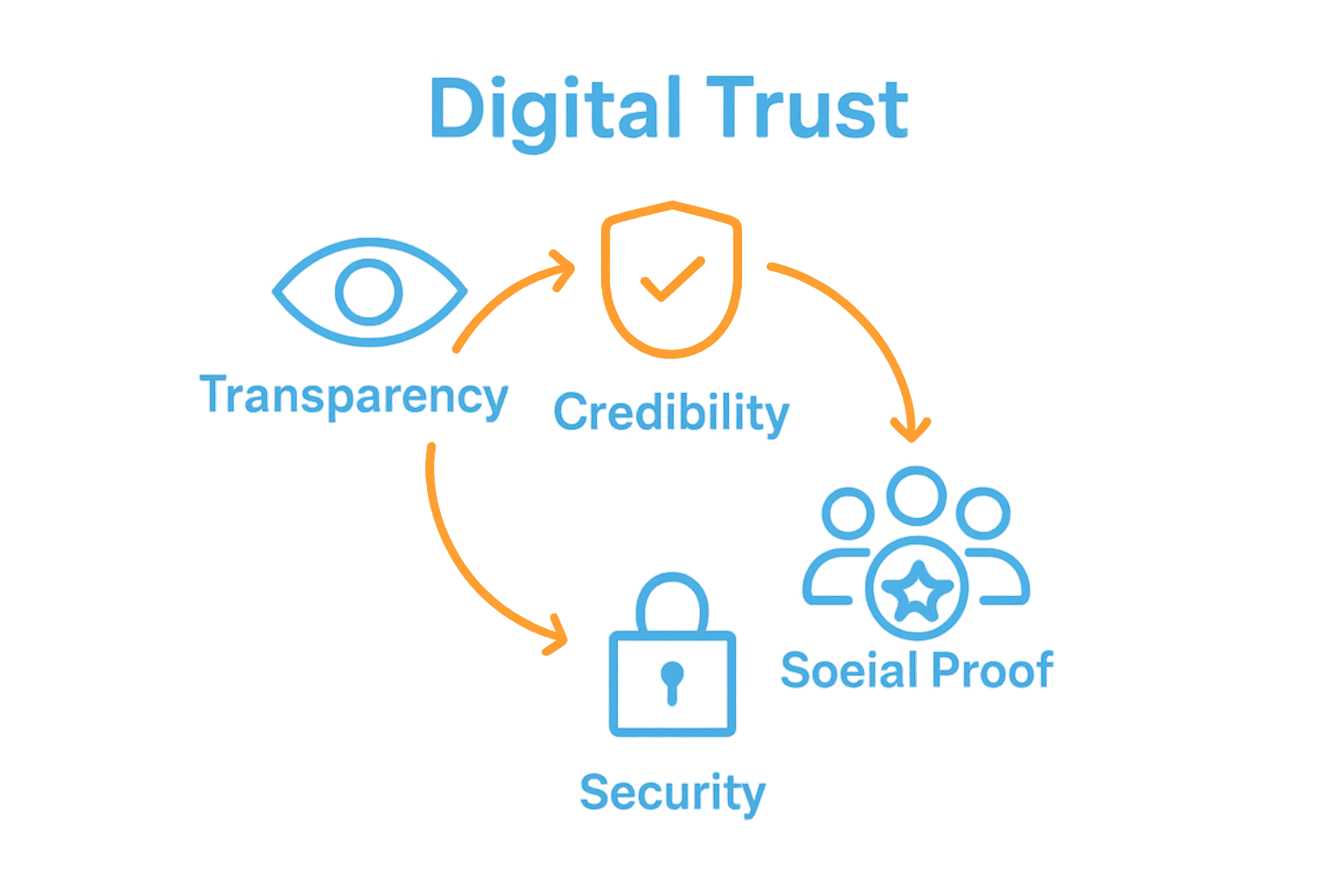Most people believe a slick website is enough to gain trust, but studies show that nearly 60 percent of users decide within seconds whether a platform feels safe. For south-african businesses competing online, trust has become the currency that defines who customers choose to support. This article unpacks what truly builds digital trust, explains why common myths persist, and reveals how south-african companies can strengthen genuine connections with their online audience.
Table of Contents
- Defining Trust Online And Common Myths
- Major Types Of Online Trust Mechanisms
- Key Strategies For Earning Digital Credibility
- Risks And Common Pitfalls In Digital Trust
- Proven Methods For Maintaining Long-Term Trust
Key Takeaways
| Point | Details |
|---|---|
| Establishing Digital Trust | Trust must be built from the first interaction through transparency, credibility, security, and social proof. |
| Continuous Trust Commitment | Trust is not a one-time achievement; it requires ongoing effort and consistent performance to maintain. |
| Risk Management | Proactively address data management, communication failures, and security vulnerabilities to protect trust. |
| Long-Term Trust Strategies | Implement comprehensive approaches for consistent performance, transparent communication, and continuous improvement to foster lasting credibility. |
Defining Trust Online and Common Myths
Trust in the digital landscape is no longer a luxury but a fundamental requirement for successful online interactions. Understanding how digital trust functions requires deconstructing complex psychological and technological mechanisms that go far beyond simple website appearances.
According to Wikipedia, swift trust theory reveals fascinating insights into how individuals rapidly establish confidence in digital environments. The theory suggests people initially assume trust and then verify it through subsequent interactions, challenging traditional linear trust-building models. This means businesses must create immediate positive signals that inspire confidence from first contact.
Key Components of Online Trust
Online trust comprises several critical elements that work together to create a comprehensive perception of reliability:

- Transparency: Clear communication about business practices
- Credibility: Demonstrable expertise and professional credentials
- Security: Robust technological safeguards protecting user data
- Social Proof: Genuine testimonials and verifiable customer experiences
Common Trust Myths Debunked
Many misconceptions prevent businesses from effectively building digital trust. Here are some prevalent myths:
-
Myth: Flashy websites automatically create trust Reality: Professional design matters, but substance trumps style
-
Myth: Trust is a one-time achievement Reality: Trust is continuously earned through consistent performance
-
Myth: Security is only about technology Reality: Trust involves human perception and emotional connection
As Wikipedia explains, trust signals like verified business badges play a crucial role in customer perception. These visual markers from reputable organizations help customers feel more secure during online transactions.
Building genuine online trust requires a holistic approach that integrates technological robustness, transparent communication, and consistent value delivery. Businesses must recognize that trust is an ongoing commitment, not a static achievement.
Major Types of Online Trust Mechanisms
Online trust mechanisms are sophisticated digital strategies designed to create confidence and reliability in virtual interactions. These mechanisms serve as critical bridges between businesses and their digital audiences, transforming abstract online connections into tangible, trustworthy experiences.
According to research from Harvard Kennedy School, online platforms employ multiple sophisticated trust mechanisms to establish credibility. These mechanisms range from user review systems to complex verification processes that validate the authenticity of digital interactions.
Primary Trust Mechanism Categories
Online trust mechanisms can be broadly categorized into several key types:
-
Reputation-Based Mechanisms
- User ratings and reviews
- Historical performance tracking
- Community feedback systems
-
Authentication Mechanisms
- Multi-factor authentication
- Identity verification processes
- Secure login protocols
-
Transparency Mechanisms
- Clear terms of service
- Open communication channels
- Detailed company information disclosure
Research from ArXiv highlights an emerging trend of integrated trust approaches, particularly in e-commerce. These approaches combine policy-based and reputation-based systems to create more robust trust frameworks that adapt to evolving digital interaction patterns.
Advanced Trust Verification Techniques
Modern trust mechanisms go beyond simple verification, incorporating sophisticated technologies:
- Machine Learning Algorithms: Detecting suspicious patterns
- Blockchain Verification: Creating immutable transaction records
- Real-Time Risk Assessment: Dynamic trust scoring
Successful online trust mechanisms recognize that trust is not a static concept but a dynamic, continuously evolving relationship between digital entities. Businesses must implement multilayered, adaptive strategies that respond to changing user expectations and technological landscapes.
The ultimate goal of these trust mechanisms is not just to prevent fraud, but to create genuine, meaningful digital connections that make users feel secure, respected, and valued in their online interactions.

Key Strategies for Earning Digital Credibility
Digital credibility is the invisible currency that determines a business’s success in the online ecosystem. It represents the complex interplay between technological reliability, transparent communication, and consistent value delivery that transforms casual online interactions into meaningful, trust-based relationships.
Research from Therapeak emphasizes that prioritizing security and privacy is fundamental to building online trust. This means implementing robust data protection protocols that go beyond basic compliance, demonstrating a genuine commitment to safeguarding user information.
Core Credibility-Building Strategies
Successful digital credibility requires a multifaceted approach:
-
Transparent Communication
- Clear, honest messaging
- Prompt and direct responses
- Consistent brand voice
-
Technical Reliability
- Stable website performance
- Secure transaction processes
- Regular security updates
-
Authentic Engagement
- Genuine customer interactions
- Visible customer support
- Proactive problem resolution
According to Therapeak, cultivating authenticity in online interactions is crucial. This means moving beyond superficial communication to create meaningful, transparent connections that demonstrate real understanding of user needs.
Advanced Credibility Techniques
Modern digital credibility extends beyond traditional approaches:
- Social Proof: Displaying genuine customer testimonials
- Expert Validation: Showcasing industry certifications
- Continuous Improvement: Demonstrating adaptability and learning
Businesses can enhance their digital credibility by understanding brand positioning strategies, which provide deeper insights into creating a consistent and trustworthy online presence.
The journey to digital credibility is ongoing. It requires persistent effort, genuine commitment, and a holistic approach that integrates technological robustness with human-centric communication. Successful businesses recognize that credibility is not a destination but a continuous process of earning and maintaining user trust.
Risks and Common Pitfalls in Digital Trust
Digital trust is a delicate ecosystem where a single misstep can dramatically erode years of carefully built credibility. The landscape of online interactions is fraught with potential pitfalls that can undermine an organization’s reputation, making continuous vigilance and strategic risk management absolutely critical.
Research from ArXiv reveals significant challenges in digital networks, particularly highlighting data sovereignty and privacy concerns that can fundamentally undermine user trust. These challenges extend beyond simple technological vulnerabilities, touching on deeper issues of user perception and organizational integrity.
Primary Digital Trust Risks
Organizations face multiple critical trust erosion risks:
-
Data Mismanagement
- Inadequate data protection protocols
- Lack of transparency in data usage
- Inconsistent privacy practices
-
Communication Failures
- Inconsistent messaging
- Delayed or absent response to user concerns
- Lack of clear communication channels
-
Security Vulnerabilities
- Weak authentication mechanisms
- Insufficient cybersecurity measures
- Delayed security patch implementation
According to research from Lausanne, a critical pitfall in digital trust mechanisms involves the reliability of user feedback. The potential for dishonest reporting can create systemic trust challenges that undermine entire digital interaction frameworks.
Strategic Risk Mitigation Approaches
Effective digital trust management requires proactive strategies:
- Continuous Monitoring: Regular security and communication audits
- Transparent Reporting: Clear, immediate communication about potential issues
- User Empowerment: Providing robust control over personal data
Businesses can gain deeper insights by exploring digital identity management, which offers comprehensive strategies for maintaining user trust.
Ultimately, digital trust is not about achieving perfection, but demonstrating genuine commitment to user protection, transparent communication, and continuous improvement. Organizations must view trust as an ongoing dialogue, not a static achievement.
Proven Methods for Maintaining Long-Term Trust
Trust is not a static achievement but a dynamic, continuously evolving relationship between organizations and their digital audiences. Sustained digital credibility requires a strategic, multifaceted approach that goes beyond superficial interactions and demonstrates genuine commitment to user needs and expectations.
Research from ArXiv introduces a sophisticated trust management model for digital services, emphasizing the critical importance of standardized service descriptions and trust-enhancing architectural frameworks. This approach recognizes that long-term trust is built through consistent, predictable, and transparent digital experiences.
Core Trust Maintenance Strategies
Successful long-term trust requires implementing comprehensive approaches:
-
Consistent Performance
- Reliable service delivery
- Predictable user experiences
- Meeting or exceeding expectations
-
Transparent Communication
- Regular, honest updates
- Clear explanation of changes
- Open feedback channels
-
Continuous Improvement
- Active user experience monitoring
- Proactive problem resolution
- Adaptive technological solutions
According to research from ABA Academies, institutional mechanisms play a crucial role in fostering online trust. This includes implementing robust security measures like advanced data encryption and secure transaction systems that transcend cultural boundaries.
Advanced Trust Preservation Techniques
Long-term digital trust requires sophisticated approaches:
- Predictive Problem Solving: Anticipating and addressing potential user concerns
- Cultural Sensitivity: Understanding diverse user expectations
- Personalized Engagement: Tailoring interactions to individual user needs
Businesses seeking deeper insights can explore strategies for digital identity management, which provide comprehensive frameworks for maintaining user confidence.
Ultimately, maintaining long-term digital trust is an ongoing commitment. It demands persistent effort, genuine empathy, and a holistic approach that integrates technological reliability with human-centric communication. Organizations must view trust not as a destination, but as a continuous journey of understanding, adapting, and delivering exceptional value.
Build Genuine Online Trust with Tailored Digital Solutions
In today’s fast-paced digital world trust is everything. The Complete Guide to Building Trust Online highlights key challenges such as establishing transparent communication safeguarding data and consistently delivering authentic engagement. If your business struggles to create that essential trust that turns visitors into loyal customers you are not alone. The article emphasises the need for robust security measures and clear messaging alongside continuous improvement — core principles that must be reflected in your online presence.
At Cloud Fusion we help businesses overcome these challenges with custom web design and development solutions crafted to boost your credibility and foster real trust with your audience. Our expert team focuses on creating scalable and secure websites that prioritise user experience transparent communication and reliable performance. Ready to make your digital presence a trust-building powerhouse? Discover how our tailored services can transform your online engagement by requesting a personalised quote at Web Design and Development Quotation. Take action now and start building meaningful trust that lasts.
Frequently Asked Questions
What are the key components of online trust?
The key components of online trust include transparency, credibility, security, and social proof. These elements work together to create a reliable perception of a business in the digital landscape.
How can businesses debunk common myths about online trust?
Businesses can debunk myths by focusing on substance over style, recognizing that trust is an ongoing process, and understanding that it involves not just technological safeguards but also human perception and emotional connection.
What are the main types of online trust mechanisms?
The main types of online trust mechanisms include reputation-based mechanisms (like user ratings and reviews), authentication mechanisms (such as multi-factor authentication), and transparency mechanisms (like clear terms of service and open communication channels).
How can businesses effectively maintain long-term digital trust?
To maintain long-term digital trust, businesses should ensure consistent performance, engage in transparent communication, and commit to continuous improvement, adapting to user needs and feedback.
Recommended
- Brand Credibility: a Key Ingredient to Improved Conversion Rates
- Link Building: How To Master Link Building for SEO & Crush The SERPs
- 9 Simple Link Building Strategies to Replicate
- Internet Marketing by Cloudfusion
- How to Find Contacts on Instagram: A Practical Guide - Hexrate
- Complete Guide to Emotional Awareness in Digital Age - Wisdom








